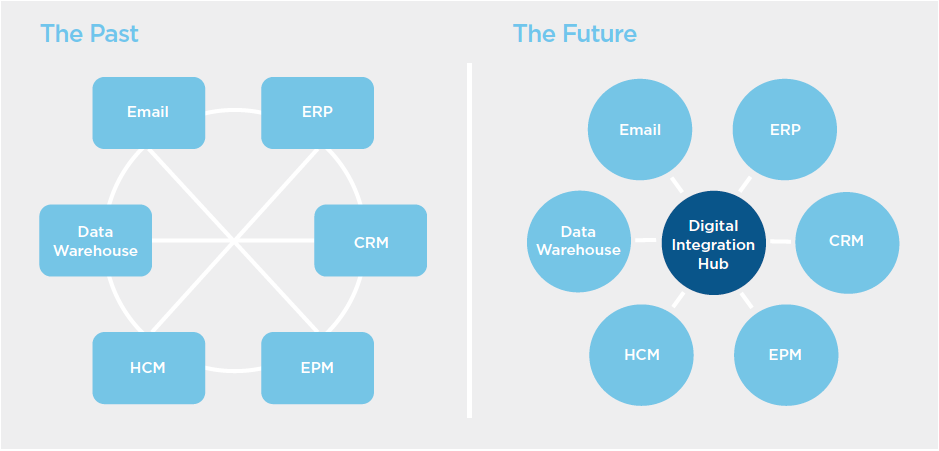In Brief
Amid major disruption and increasing competition, organizations that generate business value from their data — and thereby enable agility — will outperform their peers. The intentional integration of data sources helps businesses to unlock intelligence that can increase efficiencies and productivity, aid strategic decision making, and deliver actionable insights for improvement.
The key to ensuring this change is sustainable requires moving beyond one-off, point-by-point integrations. It lies in striving for true, comprehensive interoperability among all enterprise systems, which in turn necessitates a mindset shift toward a data culture. In the past, integration meant connecting two systems at a time in an effort to improve data coordination between those isolated points. More and more, though, leaders in this space are discovering that integration is more than that — it’s an integral part of a modern digital transformation model. To enable resilience, businesses need a unified integration strategy that runs concurrent with a larger digital transformation strategy
To enable resilience, businesses need a unified integration strategy that runs concurrent with a larger digital transformation strategy.
Moving Beyond Point-By-Point Integrations With a Digital Integration Hub
In the past, businesses would often consider integration applications one at a time, when an individual owner identified an inefficient process or a dearth of available data. This outdated model would require a different integration technology in each of these instances. Because there is no centralized point of integration, each application requires multiple connections.
A more modern approach to this dynamic revolves around the creation of a hub-and-spoke model with a digital integration hub at its core. This model allows for a more seamless data flow and minimizes the number of integrations required. This modern model illustrates a concentrated approach to integration that maximizes the organization’s investments in technology by minimizing the number of employees with different skill sets required to maintain disparate systems and connection points. It also minimizes the number of integration technologies that must be acquired and maintained. At the same time, it also enables businesses’ software architectures to become more resilient by reducing the number of potential failure points within the system.

The execution of a comprehensive integration strategy can:
- Facilitate the improvement of products and services.
- Invite a more thorough understanding of customer needs.
- Enable more effective operations.
- Improve collaboration across teams.
- Increase efficiencies by offering real-time data.
- Enhance resilience by minimizing risk from excessive data transfers.
- Maximize productivity by making data easier to find and understand.
- Improve employee engagement by improving their user experience.
Integrated Data + Improved Analytics = Better Insights
Perhaps the most significant benefit of data integration is the ability to derive actionable insights that give businesses an edge over their competitors. By connecting and consolidating data, leaders gain visibility into the organization’s performance, increase speed and agility in decision making, and improve accuracy.
Data is getting larger, faster and more diverse. This influx of knowledge can make businesses more accurate, more nimble and ultimately more successful — but only if they have the data architecture in place to make it a functional part of their decision making. Integration, when done well, empowers leaders and their staffs to leverage the massive amounts of data all modern organizations collect. It is a mechanism for making this wealth of information more usable.
Integration, when done well, empowers leaders and their staffs to leverage the massive amounts of data all modern organizations collect. It is a mechanism for making this wealth of information more usable.
Creating a centralized digital integration hub for all applications has a number of benefits. It allows for better security and a more seamless data flow. At the same time, the integration of formerly siloed applications allows businesses to improve and simplify data share, thus optimizing user experience, application performance and collaboration. As new technologies or applications are acquired, they can plug directly into this hub rather than requiring multiple point-by-point connections.
On top of increased visibility and improved access to data, this level of integration also improves speed and efficiency. It’s the difference between batch processing and real-time updates. When data is updated, users no longer have to wait overnight to access these new numbers. They have them immediately.
As a component of a larger strategy, proactively defining how each user currently uses data (or doesn’t) and what they need to be successful can improve their autonomy in accessing and analyzing critical insights that drive improvement.
The Bottom Line: Make Integration a Priority
While the move to a centralized digital integration hub can be made at any time during a digital transformation journey, to minimize expense and rework, the best time to start deploying a modern integration strategy is at the start of any major change to the organization’s technology landscape. The key is to not miss the opportunity to modernize before the organization has wasted time and resources on a less efficient approach.
Integration should be made a priority and not considered a sub-bullet of digital transformation, as many organizations have traditionally considered it. Integration approaches have evolved. Those businesses that shift to focusing on the interoperability of applications rather than point-by-point connections will find success in the long term. Their peers who shrug it off as a sub-bullet or a “nice to have” will likely struggle to make the change stick. As with any technology advancement, if organizations aren’t pushing forward, they are falling behind.
KEY TAKEAWAYS
-
Think differently.
Shift organizational mindsets to focus on the interoperability of applications rather than point-by-point connections. -
Plan differently.
Make integration strategy a major component of any digital transformation endeavor. -
Act differently.
Eliminate redundancies and streamline processes by creating a virtual command center for enterprise data integration.
